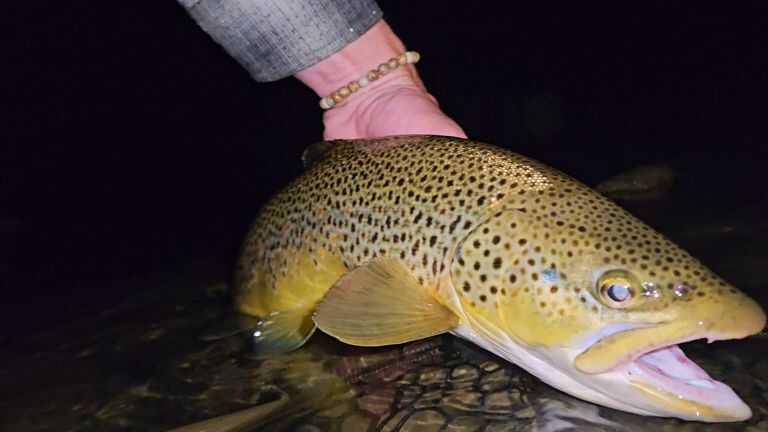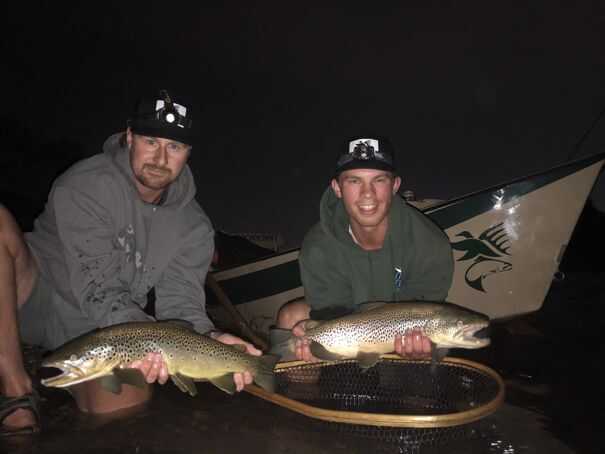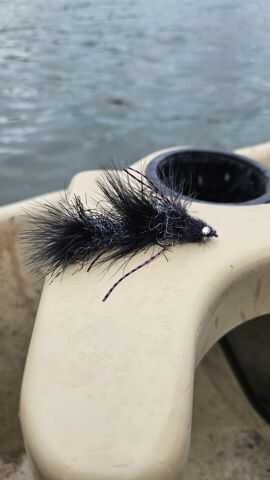

There is mystique about the night. The silence. I cannot help to wonder what monsters stir, not to be seen in the light of day. Brown trout being nocturnal, it only makes sense. But to the advantage of all trout, night is when aerial predators are held mostly at bay.
On a July night as darkness settled in, I was strolling into a gentle inside flat below a pronounced riffle. What beat me there was a pod of 120 pelicans also on the hunt. Corralling fish into a tight circle, they simultaneously put their heads down and opened their gigantic mouths. Though magnificent, it appeared frighteningly effective. I have seen this tactic during the day on lakes void of trout, but not on trout bearing streams. Pelicans take advantage of the cover of night to hunt, and so do predatory trout.
So why not hunt browns when they’re on the hunt? Oh right, you can’t see.
Well really, that’s not completely true. After a few minutes in the dark of night, our eyes adjust well.
Ambient light from the moon or nearby cities makes night fishing possible. But when it is too bright, they take away from the darkness factor we head out at night for.
A couple of things before hitting the water: familiarize yourself with a stretch of river before approaching it at night. Knowing the structure of the river and back cast limitations will keep your fly in fishy water and out of the bushes. Practice bringing your leader and fly to hand without looking. You will be far more efficient and save yourself from the hassle in the dark.
It’s a necessity to have a headlamp. Avoid turning them on when around water you plan to fish. When changing flies or retying, move and point the headlamp away from the water. Dull lights like red light are easier on your eyes and are less likely to spook fish.
To fish at night is to fish for a monster, which are not plentiful. These monsters primarily eat other fish, so streamers are on the menu. Your fly needs to be in the right place at the right time for the chance to trick a fish into eating an abomination of hair and feathers tied onto a silver hook.
Be elaborate and pick the water apart. Since there are few target fish, dissect every nook and cranny to ensure you don’t pass one by. Browns cruise slack water while on the hunt, but they will also be in prime feeding spots like seams, behind deflections, back eddies, and undercuts.


I prefer working downstream while streamer fishing from the shore. It’s easier to keep in touch with your fly since you’re not racing the current to catch up with it after a cast. Cast across the current (slightly up or downstream depending on depth), mend upstream, take a step downstream, hold the line tight and allow your streamer to swing across the current toward shore. Once down to your desired depth, strips or pulsing the rod can be mixed in to speed the fly up or give it more action. As the fly nears the end of its swing, strip it in to casting length, and give it a few more twitches with your arm to give it ‘stop and go’ action before picking it up and recasting. This is a final effort to entice a following fish to eat. Recast and repeat.
While you can fish stretches of river more intricately on foot, you can cover more river floating. Both have their benefits, but the comfort of a boat is a welcome change. Plus, there is no worrying about your back cast. Familiarity with a stretch of river is crucial while floating in the dark. Know the route and the hazards and play it conservatively.




Big browns are hunting big meals at night. Though I’m a firm believer that big fish eat small flies, particularly in pressured waters at night, bigger flies that push more water are more likely to entice a strike. They are also more likely to induce a territorial reaction. My go-to patterns are articulated streamers like sex dungeons, thrashers, and circus peanuts. The profile of a fly is more important than color. But I tend to choose darker flies like blacks and browns during the night.
As light wanes on a summer evening, caddisflies fill the air and stoneflies litter the ground. An abundance of bugs on the surface during the cover of night gets fish looking up. The reflection of ambient light on the surface gives some visibility for fishing dry flies. You may not be able to see your fly, but the ring of a rising fish is typically discernable. Nighttime caddis is one of the most consistent surface opportunities during the summer months.
Practice casting to have a keen sense of where your fly is landing. It takes an accurate cast placed in front of a rising fish to have a chance. If you think your fly is in the zone of a riser and you see it rise again, set the hook. If you don’t, you can guarantee that will be the time it eats it. Killer patterns are Klinkhammer emergers and elk hair caddis dry flies.
While stoneflies are hatching, big foam bugs can be spectacular at night. Watch for a ring and listen. Unlike caddis, you will often hear a fish take a big dry fly. Limit the length of your cast so you are working with a manageable amount of line. Minimizing slack will immensely improve your hook up rate. Adult stones on the surface are constantly on the move. Twitch your stonefly and try stripping or swinging it, especially when you can no longer see it. This will keep you in touch with your fly so you feel an eat.
Landing a fish in the dark is the next challenge. I don’t use a headlamp as it inevitably freaks the fish out. A larger net is an immense help. Otherwise, practice makes perfect. I would be lying if I said I haven’t lost fish after missing a net job. However, if they’re close to the net once, they usually find their way in. One of the most exciting parts about night fishing is when you turn your headlamp on and reveal what you brought to the net.


The tranquility of fishing at night is worth the slight sacrifice to your sleep schedule. It is an unforgiving pursuit that can be overwhelmingly rewarding. What may lack in quantity of fish is well made up for in quality.


